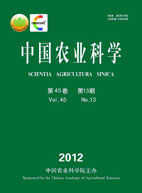-
Effect of Sowing Date on Characteristics of Photosynthesis and Matter Production of Direct Seeding Rice
- HUO Zhong-Yang, YAO Yi, ZHANG Hong-Cheng, XIA Yan, NI Xiao-Cheng, DAI Qi-Gen, XU Ke, WEI Hai-Yan
-
Scientia Agricultura Sinica. 2012, 45(13):
2592-2606.
doi:10.3864/j.issn.0578-1752.2012.13.004
-
 Abstract
(
922 )
Abstract
(
922 )
 PDF (297KB)
(
987
)
PDF (297KB)
(
987
)
 Save
Save
-
References |
Related Articles |
Metrics
【Objective】The objective of the study is to elucidate the effect of sowing date on characteristics of photosynthesis and matter production of direct seeding rice.【Method】Taking four representative rice cultivars of three types of early-maturing late japonica rice, late-maturing medium japonica rice and medium-maturing medium japonica rice (including japonica conventional rice and japonica hybrid rice) as experimental materials, the dry matter accumulation, distribution, translocation and leaf area, photosynthetic potential, crop growth rate and net assimilation rate of direct seeding rice were studied.【Result】Along with the delayed sowing date, dry matter weight of single stem and population at jointing, booting, heading, waxy stages and maturity both showed a apparent downward trend, and the difference was increasing with the growing process. Along with the delayed sowing date, the proportion of dry matter accumulation from sowing to jointing and from jointing to heading increased, but from heading to maturity decreased, while the dry matter accumulation of every stage reduced significantly or very significantly. With the growing process, leaf weight per stem and sheath weight per stem decreased, stem weight per stem firstly increased and then decreased, and panicle weight per stem increased. Along with the delayed sowing date, leaf weight per stem and sheath weight per stem decreased significantly or very significantly at booting and heading, little difference at waxy stage and increased a little at maturity, stem weight per stem and panicle weight per stem decreased significantly or very significantly at all stages. With the growing process, the proportion of leaf, stem, sheath and panicle in the later growth period had the same changes as the dry matter weight. Along with the delayed sowing date, the ratio of leaf and sheath decreased a little at booting, little difference at heading and increased significantly or very significantly at waxy stage and maturity, the ratio of stem decreased a little at booting and heading, increased a little at waxy stage and decreased at maturity, the ratio of panicle increased a little at booting, little difference at heading and decreased significantly or very significantly at waxy stage and maturity. Along with the delayed sowing date, the exportation, export rate and transformation rate of leaf, stem and sheath decreased significantly or very significantly. Along with the delayed sowing date, the leaf area index had a little difference at jointing, decreased significantly or very significantly at booting, heading and waxy stages, and decreased a little at maturity, the photosynthetic potential from sowing to jointing, jointing to heading and the whole growth period decreased significantly or very significantly, and decreased from heading to maturity, but the difference was little not significant. Along with the delayed sowing date, the crop growth rate from sowing to jointing increased significantly, little difference from jointing to heading and decreased significantly from heading to maturity, the net assimilation rate from sowing to jointing and from jointing to heading increased obviously, but decreased obviously from heading to maturity.【Conclusion】Sowing date had a great effect on characteristics of photosynthesis and matter production of direct seeding rice. Compared to sowing late, sowing early has the advantages that the dry matter accumulation is appropriate in the early stage and significantly higher in the middle and late stages, so the total dry matter accumulation is significantly higher and its distribution is reasonable, the export and transformation rate is high, and the photosynthetic production capacity is great after heading.









